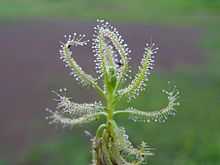Drosera indica
| Drosera indica | |
|---|---|
_in_Narsghapur%2C_AP_W_IMG_0951.jpg) | |
| D. indica in Narsapur, Medak district, India | |
| Scientific classification | |
| Kingdom: | Plantae |
| (unranked): | Angiosperms |
| (unranked): | Eudicots |
| (unranked): | Core eudicots |
| Order: | Caryophyllales |
| Family: | Droseraceae |
| Genus: | Drosera |
| Species: | D. indica |
| Binomial name | |
| Drosera indica L. | |
Drosera indica is an insectivorous plant, a sundew native to tropical countries throughout the world, from Australia and Asia to Africa, but absent from the neotropics.[1] Together with D. hartmeyerorum it makes up the section Arachnopus.
Description
D. indica is an unbranched, annual herbaceous plant, supported by a fibrous root system and reaching a height of 5–50 cm (2–20 in). Leaves are narrowly linear, up to 10 cm [4 in] long with 1-1.5 cm [0.4-0.6 in] pedicels.[2] Young plants stand upright, while older ones form scrambling stems with only the newest growth exhibiting an upright habit. The plant can be yellow-green to maroon in color. Flower petals can be white, pink, orange, or purple.[2] Its chromosome count is 2n=28.[3]
References
- ↑ Schlauer, J. 2011. World Carnivorous Plant List - Nomenclatural Synopsis of Carnivorous Phanerogamous Plants. Retrieved 30 March 2011.
- ↑ 2.0 2.1 Lowrie, Alan. 1998. Carnivorous Plants of Australia, volume 3. University of Western Australia Press. p. 180.
- ↑ Kondo, K. 1969. Chromosome numbers of carnivorous plants. Bulletin of the Torrey Botanical Club, 96(3): 322-328.
External links
![]() Media related to Drosera indica at Wikimedia Commons
Media related to Drosera indica at Wikimedia Commons
